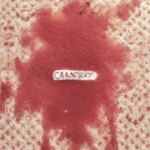Juice Tips and Tricks
How To Get Cranberry Juice Out Of White Shirt

As someone who loves cranberry juice, I know how frustrating it can be to accidentally stain a favorite white shirt. But don’t worry, a few simple steps can easily remove the stain and protect your shirt from harm.
The key to successfully removing cranberry juice stains is to act quickly and use the right methods. In this article, I will share with you my tried and tested methods for getting cranberry juice out of a white shirt.
So, let’s get started and say goodbye to those pesky stains for good!
Key Takeaways
- Quick stain removal is important to prevent setting.
- Cold water is the best option for cranberry juice stains.
- Dish soap and vinegar can be effective in removing the stain.
- Always test any solution on a small area of the fabric first.
Act Quickly
You’ve got to act fast if you want to get that cranberry juice stain out of your white shirt. Quick stain removal is crucial in preventing the stain from setting in the fabric.
The longer you wait, the harder it will be to remove the stain completely. So as soon as the spill happens, grab a clean cloth and start blotting the stain. Do not rub the stain, as this will only push it deeper into the fabric.
Importance of acting fast can’t be emphasized enough. Once the stain sets, it becomes more difficult to remove, and you may end up having to live with a permanent stain. So, act quickly and blot the stain as soon as possible.
After you’ve blotted the stain, it’s time to assess the fabric and determine the best course of action.
Assess the Fabric
Before attempting to remove a stain from a piece of clothing, it’s important to assess the fabric. As someone who’s dealt with many stains in my time, I always start by checking the care label to ensure I’m using the right method.
Next, I determine the fabric type to avoid any damage or discoloration. These simple steps can save you time, money, and frustration in the long run.
Check the care label
When dealing with a cranberry juice stain on your white shirt, take a moment to check the care label for any specific instructions on how to treat the garment. Understanding the symbols on the care label is crucial to ensuring that you don’t damage the fabric further.
If you’re unsure what the symbols mean, consult a professional or do some research online to ensure that you’re treating the garment correctly. The care label will also tell you what type of cleaning methods to avoid.
For example, if the label says ‘dry clean only,’ don’t attempt to wash the shirt yourself, as this could cause irreparable damage to the fabric. Once you have checked the care label, you can move on to determining the fabric type to choose the best cleaning method.
Determine the fabric type
To properly treat the cranberry juice stain on your white shirt, it’s important to identify the fabric type of your garment and choose an appropriate cleaning method.
Identifying the fabric type can be done by checking the care label on the garment, which usually provides instructions on how to wash and dry the fabric. The label may also indicate the type of fabric, such as cotton, polyester, silk, or wool.
Once you have identified the fabric type, you can use fabric care tips to determine the best way to remove the stain. For example, if the fabric is delicate, you may need to use a gentler cleaning method, such as using a mild detergent or hand-washing the garment. On the other hand, if the fabric is more durable, you may be able to use a stronger cleaning solution or even bleach.
By taking the time to properly identify the fabric type and choose an appropriate cleaning method, you can increase the chances of successfully removing the cranberry juice stain from your white shirt.
Now that you have identified the fabric type and chosen an appropriate cleaning method, the next step is to use cold water to help remove the stain.
Use Cold Water
Using cold water is the best way to get cranberry juice out of a white shirt, so don’t hesitate to give it a shot. Not only is it effective, but it also has numerous benefits. Firstly, cold water helps prevent the stain from setting in, making it easier to remove. Additionally, it is a gentle approach that won’t damage the fabric or cause any discoloration.
To effectively use cold water, start by running the stained area under cold water. Then, soak the shirt in a bowl of cold water for at least 30 minutes. If the stain persists, rub a bit of detergent onto the stain before washing the shirt in cold water. By using this method, you can easily get rid of the cranberry juice stain without causing any damage to your shirt. Furthermore, using cold water to remove stains is an excellent preventative measure for future stains.
Now that you’ve tried using cold water, it’s time to move on to the next step: trying dish soap. This method is also effective for removing cranberry juice stains, and I’ll explain how in the next section. Simply apply a small amount of dish soap directly to the stained area and gently blot or rub it in with a clean cloth. After letting it sit for a few minutes, rinse the stain with cold water again, and you should notice significant progress in removing cranberry juice stains. For tougher spots, repeating the process might be necessary to fully eliminate the discoloration.
Try Dish Soap
Don’t panic if your favorite shirt has been stained by a pesky red liquid- there’s a solution! Try using dish soap to easily remove the stubborn mark.
Dish soap is a great alternative method to remove cranberry juice from your white shirt. Its powerful formula can break down the stain and lift it from the fabric.
To use dish soap, first, wet the stained area with cold water. Then, apply a small amount of dish soap directly onto the stain and rub it in gently. Let the soap sit on the fabric for about 5 minutes before rinsing it off with cold water. Repeat the process until the stain is completely removed.
As a precautionary measure, always test the soap on a small, inconspicuous area of your shirt before using it on the stain.
Now that you’ve tried dish soap as a solution, it’s time to move on to the next step: using vinegar. This method is also effective in removing cranberry juice stains from white shirts.
Use Vinegar
So, when it comes to getting cranberry juice out of a white shirt, I always turn to vinegar.
To get started, I mix some vinegar and water together in a bowl.
Then, I soak the stain in the mixture for about 30 minutes before washing the shirt as usual.
This method hasn’t failed me and always leaves my white shirts looking as good as new.
Mix vinegar and water
First, you’ll need to mix equal parts vinegar and water to create a powerful stain-fighting solution. Not only is vinegar an effective cleaning agent, but it also has a multitude of other uses in household cleaning. It can be used to remove odors, clean surfaces, and even unclog drains.
By mixing it with water, you’ll create a solution that’s gentle enough to use on your shirt, but strong enough to remove that stubborn cranberry stain. To make the solution, simply mix one part vinegar with one part water. You can use any type of vinegar, but white vinegar is the most commonly used for cleaning purposes.
Once you’ve mixed the solution, apply it directly to the stain and let it sit for at least 10 minutes. This will give the vinegar time to break down the stain and make it easier to remove. Soak the stain in the mixture before moving on to the next step.
Soak the stain in the mixture
Now that you’ve mixed the solution, simply apply it directly onto the stain and let it soak for at least 10 minutes to break down the stubborn stain.
Vinegar and water are effective in removing cranberry juice stains from white shirts. However, if the stain persists, there are alternative solutions that you can try.
Here are some precautions to take when using vinegar and water to remove cranberry juice stains from white shirts:
- Test the solution on a small, inconspicuous area of the shirt first to ensure it doesn’t cause any damage or discoloration.
- Don’t rub the stain vigorously as this can cause the stain to spread and become more difficult to remove.
- Rinse the shirt thoroughly with cold water after soaking to remove any remaining vinegar solution.
- If the stain is still visible after soaking, repeat the process or try an alternative solution.
To further remove the stain, the next step is to apply baking soda onto the affected area.
Apply Baking Soda
You can sprinkle baking soda directly onto the cranberry juice stain and gently rub it in with your fingers. Baking soda’s benefits go beyond baking; it’s also an effective cleaning agent. Its mild abrasive properties help to remove stains from fabric without damaging it.
Baking soda is readily available and affordable, making it a convenient option for removing cranberry juice stains from your white shirt. Removing stains with baking soda is a straightforward process. After applying the baking soda, let it sit for a few minutes to give it time to absorb the stain.
Then, wash the shirt in cold water with regular laundry detergent. If the stain persists, try hydrogen peroxide.
Try Hydrogen Peroxide
To effectively remove a stubborn cranberry juice stain from a white shirt, it’s worth trying hydrogen peroxide. Here are some alternative solutions you can try:
-
Mix equal parts of hydrogen peroxide and liquid dish soap, then apply this mixture directly to the stain. Let it sit for 10-15 minutes before washing the shirt in cold water.
-
If the stain is particularly stubborn, soak the shirt in a solution of one part hydrogen peroxide and two parts water for 30 minutes before washing it as usual.
-
Always test a small, inconspicuous area of the shirt before applying hydrogen peroxide, as it can sometimes bleach the fabric or cause discoloration.
It’s important to take some precautions when using hydrogen peroxide to remove a stain. For example, never mix it with ammonia or vinegar, as this can create toxic fumes. Also, avoid using hot water, as this can set the stain and make it more difficult to remove. Instead, always use cold water when treating a cranberry juice stain with hydrogen peroxide.
If none of these methods work, it may be time to use a stain remover. But before moving on to the next step, it’s always worth trying hydrogen peroxide first, as it can be an effective and inexpensive solution for removing stubborn stains.
Use a Stain Remover
If the stain remains after trying hydrogen peroxide, it’s time to consider using a stain remover to finally tackle the stubborn mark. Stain removal products are readily available in most stores and can be effective in removing cranberry juice stains from white shirts. Before using a stain remover, it’s important to read the label and follow the instructions carefully to avoid damaging the fabric.
Alternatively, if you prefer a more natural approach, there are also DIY stain remover recipes that you can make at home using common household items such as vinegar, baking soda, and lemon juice. These recipes can be just as effective as store-bought products and are often more environmentally friendly. However, it’s important to note that some of these ingredients can also cause damage to certain types of fabrics, so it’s important to do a spot test first.
To ensure that the stain is completely removed, it’s important to follow up with a wash of the shirt.
Wash the Shirt
After using a stain remover, it’s important to wash the shirt as soon as possible to prevent the stain from setting in. Pre-treating stains can be helpful, but it’s not always enough to completely remove the stain. That’s where washing the shirt comes in.
When washing a shirt that has cranberry juice stains, it’s important to choose the right detergent. Look for a detergent that contains enzymes, which are specifically designed to break down protein-based stains like cranberry juice.
Before washing the shirt, check the care label to make sure it can be machine washed. If it can, turn the shirt inside out and wash it in cold water. Hot water can set the stain in, making it even more difficult to remove. Use the recommended amount of detergent and avoid using fabric softeners, which can leave a residue on the shirt that can attract more stains.
Once the cycle is complete, inspect the shirt to see if the stain has been removed. If it’s still there, repeat the washing process, or consider taking the shirt to a professional cleaner.
Now that the shirt has been washed, it’s time to air dry it. Hanging the shirt on a clothesline or laying it flat on a towel is the best way to air dry it. Avoid using a dryer, as the heat can set the stain in.
Once the shirt is completely dry, check to make sure the stain has been completely removed. If it hasn’t, repeat the washing process again or take it to a professional cleaner. With the right pre-treating and washing techniques, you can successfully remove cranberry juice stains from a white shirt.
Air Dry the Shirt
Now, hang or lay your shirt flat to air dry, making sure to avoid using a dryer as the heat can set in any remaining stains. Air drying your clothes has many benefits, including preserving the quality of the fabric, saving energy and money, and reducing your carbon footprint. By air drying your shirt, you will ensure that it stays in its original shape and size, preventing shrinkage and maintaining its color.
To prevent shrinkage while air drying, there are a few tips to keep in mind. First, make sure to reshape the garment while it’s still wet, gently pulling and smoothing it out to its original shape. Secondly, avoid hanging heavy garments, like sweaters, on hangers, as this can stretch out the fabric and cause it to lose its shape. Instead, lay them flat on a clean, dry surface. Finally, consider using a fabric softener or dryer sheet to reduce static cling and keep your clothes feeling soft and smooth. By following these tips, you can ensure that your shirt will dry properly and stay looking its best.
Frequently Asked Questions
Can you use warm water instead of cold water to remove cranberry juice stains from a white shirt?
I wouldn’t recommend using warm water to remove cranberry juice stains from a white shirt. Using hot water can actually set the stain in further. Instead, try a pre-washing treatment before washing with cold water.
Is it safe to use dish soap on delicate fabrics?
I wouldn’t recommend using dish soap on delicate fabrics as it can have a harsh impact on the fabric fibers. Alternative solutions include using a specific fabric cleaner or consulting a professional cleaner to avoid damaging the delicate fabric.
How long should you let the vinegar soak on the stain before washing the shirt?
When using vinegar to remove stains, it is important to consider the fabric type. I recommend letting it soak on non-delicate fabrics for 15-30 minutes before washing. However, precautions should be taken when using vinegar on delicate fabrics. Also, the effectiveness of vinegar on other types of stains may vary.
Can you use hydrogen peroxide on colored shirts to remove cranberry juice stains?
I wouldn’t recommend using hydrogen peroxide on colored shirts to remove cranberry juice stains. Instead, consider using bleach alternatives or pre-treating options specifically designed for colored fabrics. Always follow the care instructions on the garment label.
Are there any specific types of stain removers that work best for cranberry juice stains on white shirts?
When it comes to cranberry juice stains on white shirts, I’ve found that alternative methods and homemade remedies work best. One interesting statistic is that vinegar can remove up to 80% of stains.
Conclusion
Well, that was quite a mess! But don’t worry, you can easily remove cranberry juice stains from your white shirt with a few simple steps.
Remember to act quickly, assess the fabric, and use cold water to avoid setting the stain. If the stain is stubborn, try dish soap or vinegar for a natural solution. Hydrogen peroxide can also be effective, but be cautious with delicate fabrics.
A stain remover can be used as a last resort, but always follow the instructions carefully. Once you’ve treated the stain, wash the shirt and air dry it to avoid damaging the fabric.
As the saying goes, "an ounce of prevention is worth a pound of cure."To avoid future stains, consider wearing an apron or being extra careful when enjoying cranberry juice. With these tips, you can keep your white shirts looking fresh and clean.
Cindy thoroughly researches juicing trends, techniques, and recipes to provide readers with practical advice and inspiration. Her writing style is accessible, engaging, and designed to make complex concepts easy to understand. Cindy’s dedication to promoting the advantages of juicing shines through her work, empowering readers to make positive changes in their lives through the simple act of juicing.
Juice Tips and Tricks
How to Make Aloe Vera Juice Taste Better

Tired of the strong flavor of aloe vera juice? No problem, we’ve got the answer for you.
In this article, we’ll share some tips and tricks to make your aloe vera juice taste better. We have tried and tested various methods to enhance the flavor without compromising the health benefits.
From choosing the right juice to adding natural sweeteners and infusing with fruits and herbs, we’ve got all the information you need to transform your aloe vera juice into a delightful and refreshing beverage.
Let’s dive in!
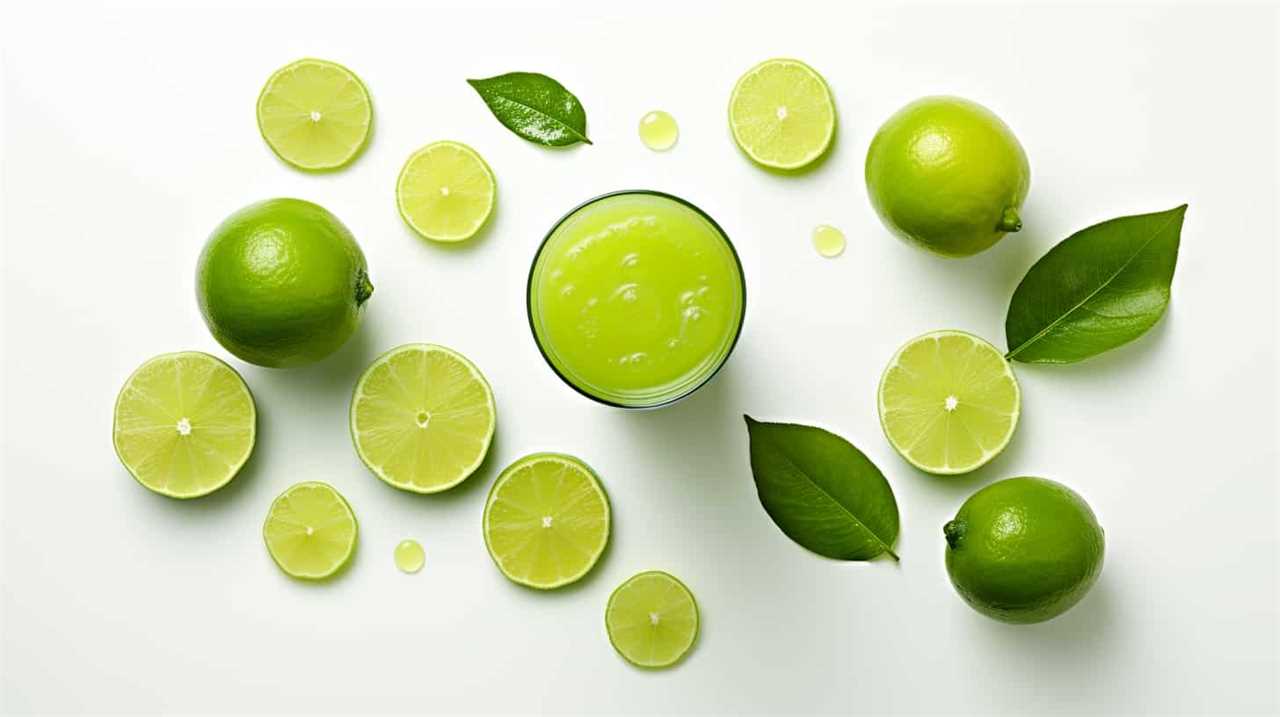
Key Takeaways
- Choose a reputable brand of aloe vera juice that prioritizes quality and uses organic, pure aloe vera.
- Avoid brands that contain added sugars or artificial ingredients.
- Use natural sweeteners like honey, agave syrup, or stevia to enhance the taste of aloe vera juice.
- Experiment with adding fruits, herbs, and other juices to create unique flavor combinations and enhance the health benefits of aloe vera juice.
Choosing the Right Aloe Vera Juice
We can enhance our experience with aloe vera juice by selecting the right brand and type for our preferences. When it comes to finding a reputable brand, it’s important to do some research and read reviews from other consumers. Look for brands that prioritize quality and use organic, pure aloe vera without any added sugars or artificial ingredients. Understanding the health benefits of aloe vera juice is also crucial in making the right choice. Aloe vera is known for its soothing properties, aiding digestion, promoting skin health, and boosting the immune system. By choosing a high-quality brand, we can ensure that we’re getting the maximum benefits from our aloe vera juice.
Now that we know how to choose the right brand, let’s move on to the next step of adding natural sweeteners.
Adding Natural Sweeteners
To enhance the flavor of our aloe vera juice, we can add natural sweeteners such as honey or agave syrup. Using alternative sweeteners not only adds sweetness but also brings unique flavors to the juice. Here are some options to consider:
- Stevia: A natural sweetener derived from the Stevia plant, it’s a zero-calorie alternative to sugar.
- Maple Syrup: This natural sweetener adds a rich and earthy flavor to the aloe vera juice.
- Dates: Pureed dates can be used to sweeten the juice while also providing essential nutrients like fiber.
In addition to using alternative sweeteners, we can enhance the flavor of aloe vera juice by adding spices and extracts. Cinnamon, ginger, or vanilla extract can add warmth and depth to the taste. By experimenting with different combinations of these natural sweeteners, spices, and extracts, we can create a flavor profile that suits our preferences.
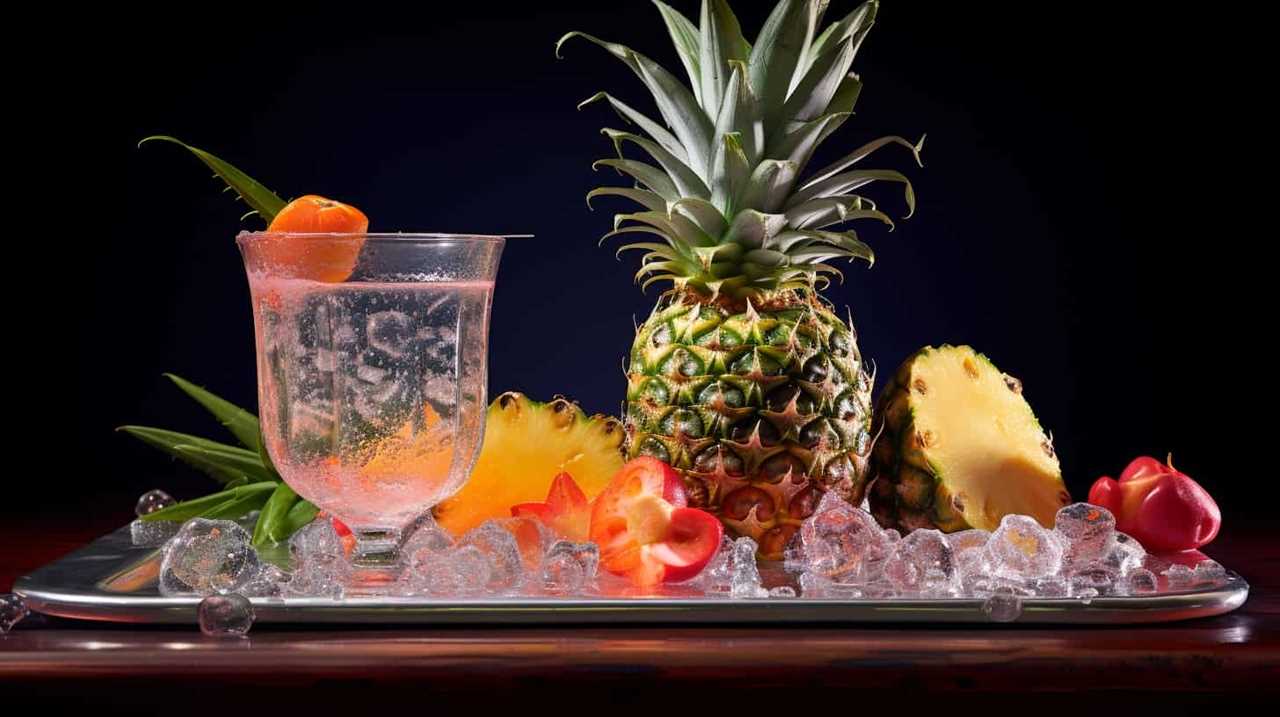
Now, let’s move on to the next section and learn how to infuse aloe vera juice with fruits and herbs to further enhance its taste.
Infusing With Fruits and Herbs
As we explore ways to make our aloe vera juice taste better, one option to consider is infusing it with fruits and herbs. Creating unique aloe vera blends by adding fruits and herbs not only enhances the flavor but also adds a touch of freshness and complexity to the juice. For example, combining aloe vera juice with lemon, mint, or berries can create a refreshing drink that’s both delicious and packed with additional nutrients. It’s similar to the ease of making lemonade with bottled juice—quick, convenient, and customizable to suit your preferences. By experimenting with different fruit and herb combinations, you can elevate your aloe vera juice experience while still reaping its health benefits.
Fruits like strawberries, pineapple, or citrus can add a burst of sweetness, while herbs like mint, basil, or ginger can provide a subtle yet refreshing twist. Exploring the benefits of herbal infusions can also be beneficial for our health. For example, adding a few sprigs of lavender can promote relaxation and reduce stress. Additionally, infusing aloe vera juice with rosemary can aid digestion and boost the immune system.
Blending With Other Juices
Let’s try mixing aloe vera juice with different fruit juices to create delicious and refreshing blends. Blending aloe vera juice with other fruits not only enhances its taste but also adds nutritional benefits to your drink. Here are three fruit juices that you can mix with aloe vera juice:

- Orange juice: Combining aloe vera juice with orange juice not only adds a tangy flavor but also boosts your intake of vitamin C, which is essential for a strong immune system.
- Pineapple juice: Mixing aloe vera juice with pineapple juice creates a tropical blend that isn’t only refreshing but also helps in digestion. Pineapple contains bromelain, an enzyme that aids in breaking down proteins and promoting better digestion.
- Watermelon juice: Blending aloe vera juice with watermelon juice creates a hydrating and refreshing combination. Watermelon is rich in water content and contains electrolytes that can help replenish your body’s fluids.
Experimenting With Flavor Combinations
While we can try various flavor combinations with aloe vera juice, it’s important to find the right balance to enhance its taste. Experimenting with different flavors can’t only make the juice more enjoyable but also enhance its health benefits.
Aloe vera juice is known for its numerous health benefits, such as boosting digestion, promoting hydration, and supporting the immune system. By adding complementary flavors, we can create a refreshing summer drink that not only tastes great but also provides a nutritional boost.
Some popular flavor combinations include mixing aloe vera juice with citrus fruits like lemon or orange, adding a splash of coconut water for a tropical twist, or combining it with cucumber and mint for a refreshing and cooling effect.
Don’t be afraid to get creative and find the flavor combination that suits your taste buds best!
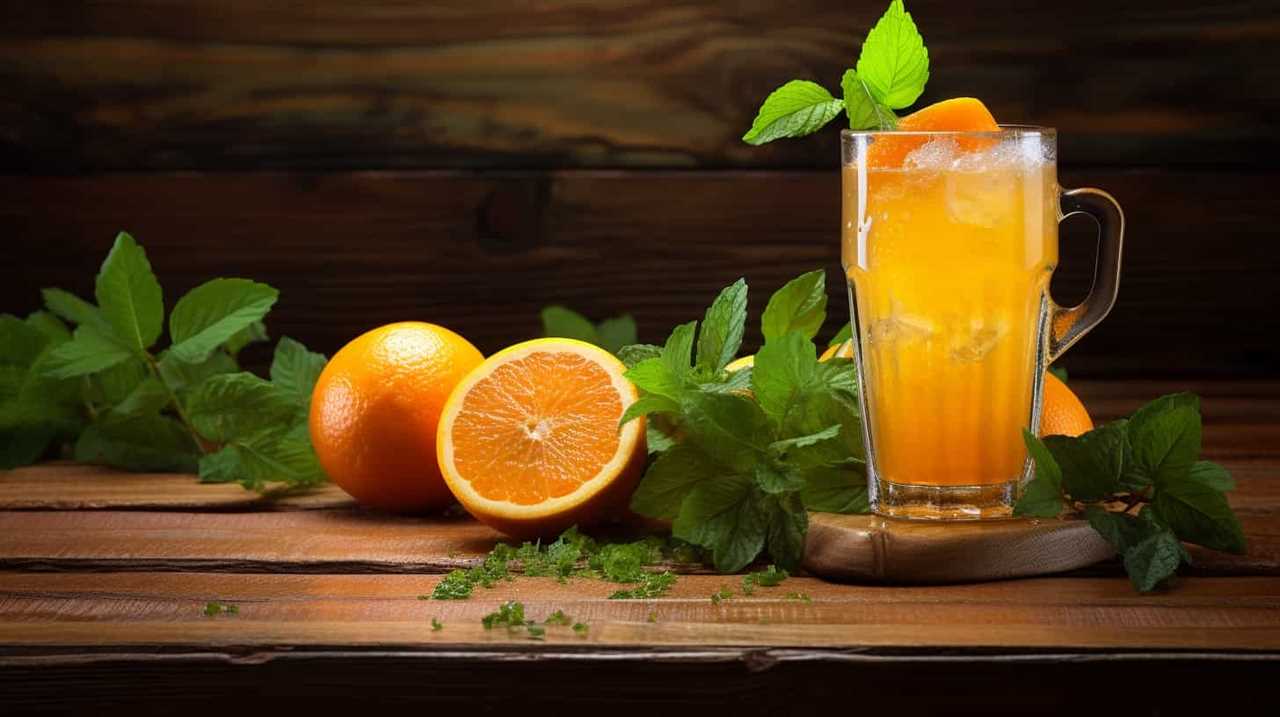
Frequently Asked Questions
Can I Use Store-Bought Aloe Vera Gel Instead of Fresh Aloe Vera for Making Juice?
Yes, you can use store-bought aloe vera gel instead of fresh aloe vera for making juice. However, it’s important to note that fresh aloe vera juice may have more health benefits due to its higher nutrient content.
How Long Can I Store Aloe Vera Juice in the Refrigerator?
Aloe vera juice can be stored in the refrigerator for up to a week. Refrigeration helps maintain the longevity and freshness of the juice, preserving its beneficial properties. It’s important to store the juice in an airtight container to prevent contamination and maintain its quality. Similarly, you might wonder *how long ginger juice lasts*; typically, fresh ginger juice can be refrigerated for about 1–2 weeks as well. Both aloe vera and ginger juices are best consumed within their shelf life to ensure maximum potency and health benefits. Additionally, freezing either juice can extend their shelf life, though some loss of nutrients and potency may occur during the process. When thinking about *how long fresh juice lasts*, it’s crucial to check for signs of spoilage, such as changes in smell, taste, or color, before consuming. To enjoy the best results, it’s always recommended to use fresh ingredients and properly store the juice to ensure you’re getting the most out of its health benefits.
Can Aloe Vera Juice Help With Digestive Issues?
Aloe vera juice can potentially help with digestive issues when taken in appropriate dosages. However, it is important to note that there may be potential side effects. It is always best to consult with a healthcare professional before starting any new supplement regimen.
Can I Use Artificial Sweeteners Instead of Natural Sweeteners in My Aloe Vera Juice?
Using artificial sweeteners in aloe vera juice may affect its taste and potential health benefits. However, natural sweeteners like honey or stevia can enhance the flavor without compromising its nutritional value.

Is It Safe to Drink Aloe Vera Juice Every Day?
Drinking aloe vera juice daily can have numerous benefits, such as improving digestion and boosting the immune system. However, consuming it regularly may also lead to potential side effects like diarrhea or stomach cramps.
Conclusion
In conclusion, making aloe vera juice taste better is easy and enjoyable.
By choosing the right aloe vera juice and adding natural sweeteners, infusing with fruits and herbs, blending with other juices, and experimenting with flavor combinations, you can create a delightful and refreshing drink.
So go ahead and unleash your creativity in the kitchen, and transform your aloe vera juice into a sensational elixir that will transport your taste buds to paradise.
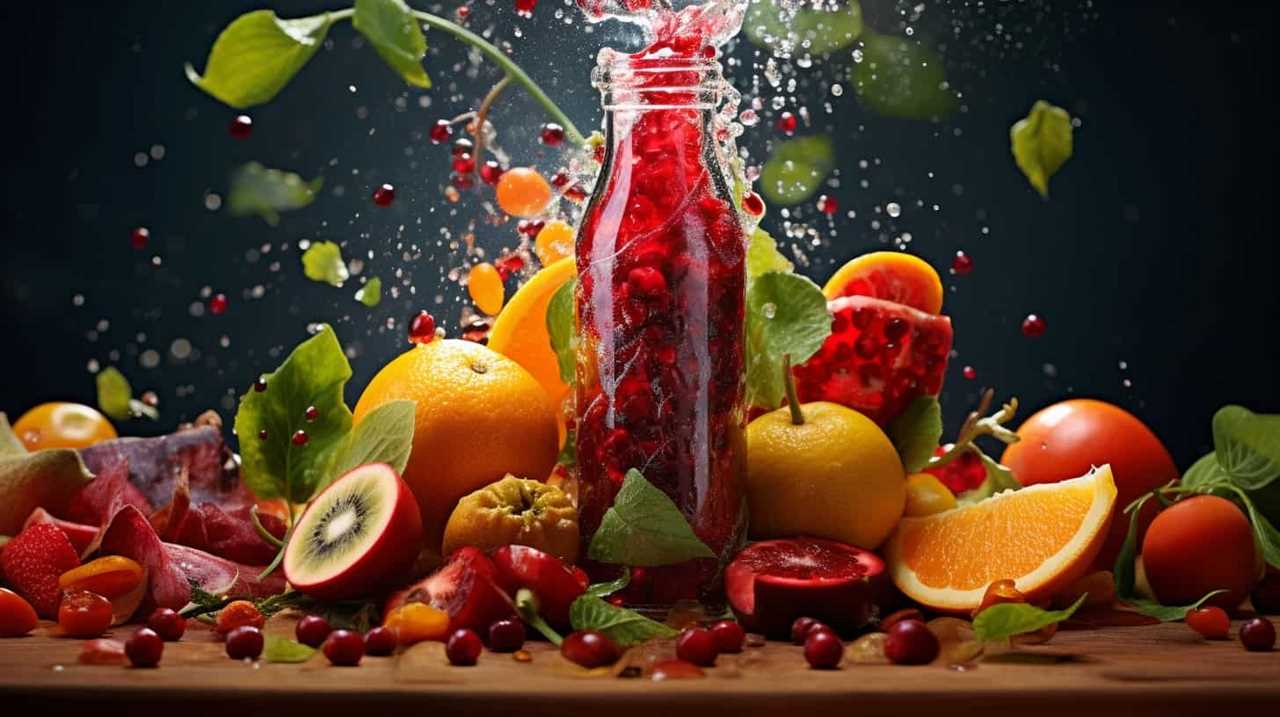
Susannah expertise lies in researching and compiling evidence-based content on juicing, nutrition, and overall health. She is committed to ensuring that The Juicery World offers accurate, up-to-date, and trustworthy information to empower readers to take control of their health. Susannah’s goal is to inspire individuals to embrace juicing as a way to nourish their bodies and live their best lives.
Juice Tips and Tricks
How to Make a Glass of Lemonade With Bottled Lemon Juice
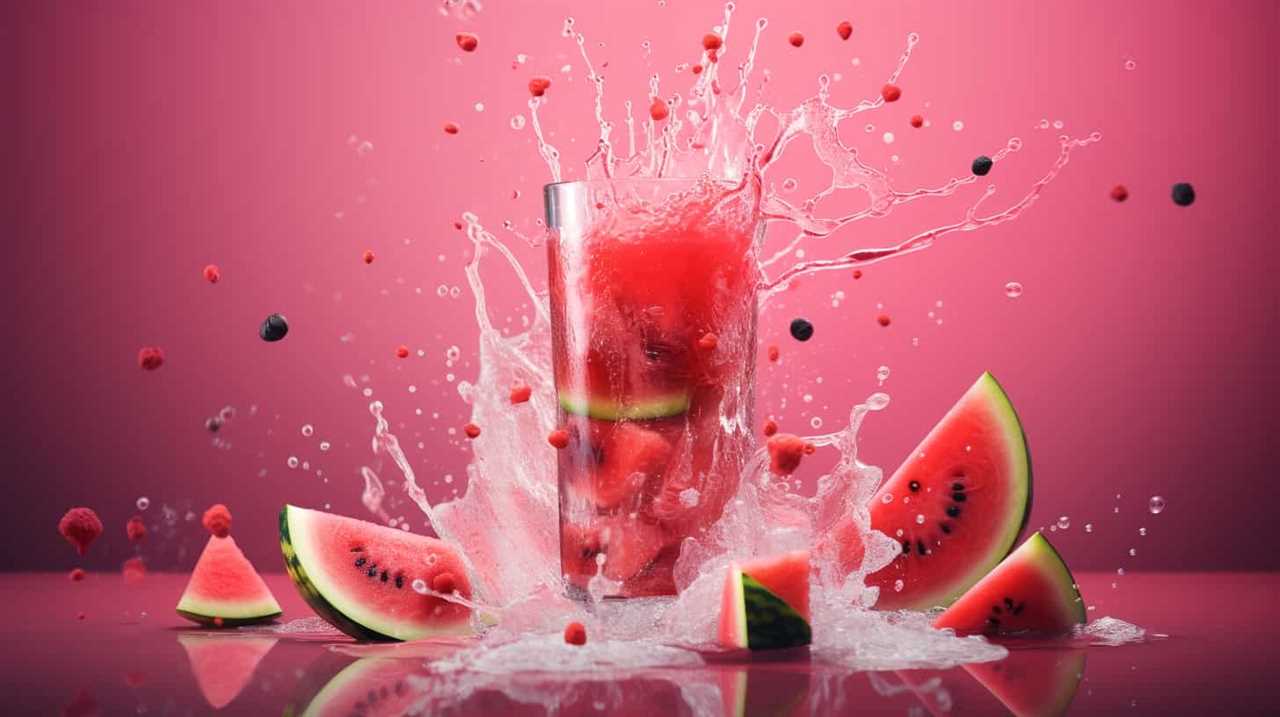
Are you craving a cool glass of lemonade to quench your thirst? Look no further! Try out our perfect recipe using bottled lemon juice that will surely please your taste buds.
In this article, we’ll guide you through the process of creating a tangy and sweet concoction that will leave you feeling refreshed and satisfied.
So grab your ingredients and let’s get started on this delightful journey of serving ourselves and others a glass of pure lemony goodness.
Key Takeaways
- Consider the storage of the bottled lemon juice (dark glass or plastic bottles, protect from light exposure, check expiration date)
- Choose a suitable pitcher and fresh lemons for enhanced flavor
- Store the lemonade concentrate in the refrigerator to maintain freshness
- Adjust the sweetness and tartness to taste with sugar or more lemon juice, and experiment with different sweeteners or additional flavors.
Choosing the Right Bottled Lemon Juice
What are the key factors we should consider when selecting the right bottled lemon juice for our lemonade?

One important factor is how the lemon juice is stored. Look for bottles that are made of dark glass or plastic, as they help protect the juice from light exposure, which can degrade its quality. It’s also important to check the expiration date to ensure freshness.
Another benefit of using bottled lemon juice is convenience. It saves time and effort compared to squeezing fresh lemons. Additionally, bottled lemon juice provides consistent flavor, as the acidity levels are standardized.
When selecting a brand, consider reading reviews and checking for certifications, such as organic or non-GMO.
Gathering the Necessary Ingredients and Tools
How can we gather all the necessary ingredients and tools to make a glass of lemonade with bottled lemon juice? First, we’ll need to collect bottled lemon juice, sugar, and cold water, as well as a pitcher and a spoon for mixing. If you prefer extra flavor, you can also gather ice and optional add-ins like mint or soda water. While preparing the lemonade, it’s easy to understand why some people wonder about other citrus drinks and may ask, “how many oranges per gallon” are needed when making orange juice instead. Once everything is assembled, combine the lemon juice, sugar, and water in the pitcher, stirring until the sugar dissolves. Feel free to adjust the sweetness or tartness to your liking, and don’t forget to add ice or any optional add-ins for an extra refreshing touch. This process might even make you curious about how much juice from oranges is needed when making fresh orange juice compared to using bottled citrus products. Once your lemonade is ready, pour it into a glass and enjoy the refreshing taste. This simple recipe can inspire you to try other homemade juices, such as learning **how to make pear juice** or experimenting with other fruit combinations. Whether you’re using fresh fruits or bottled options, creating your own beverages is a fun and rewarding way to personalize your drinks.
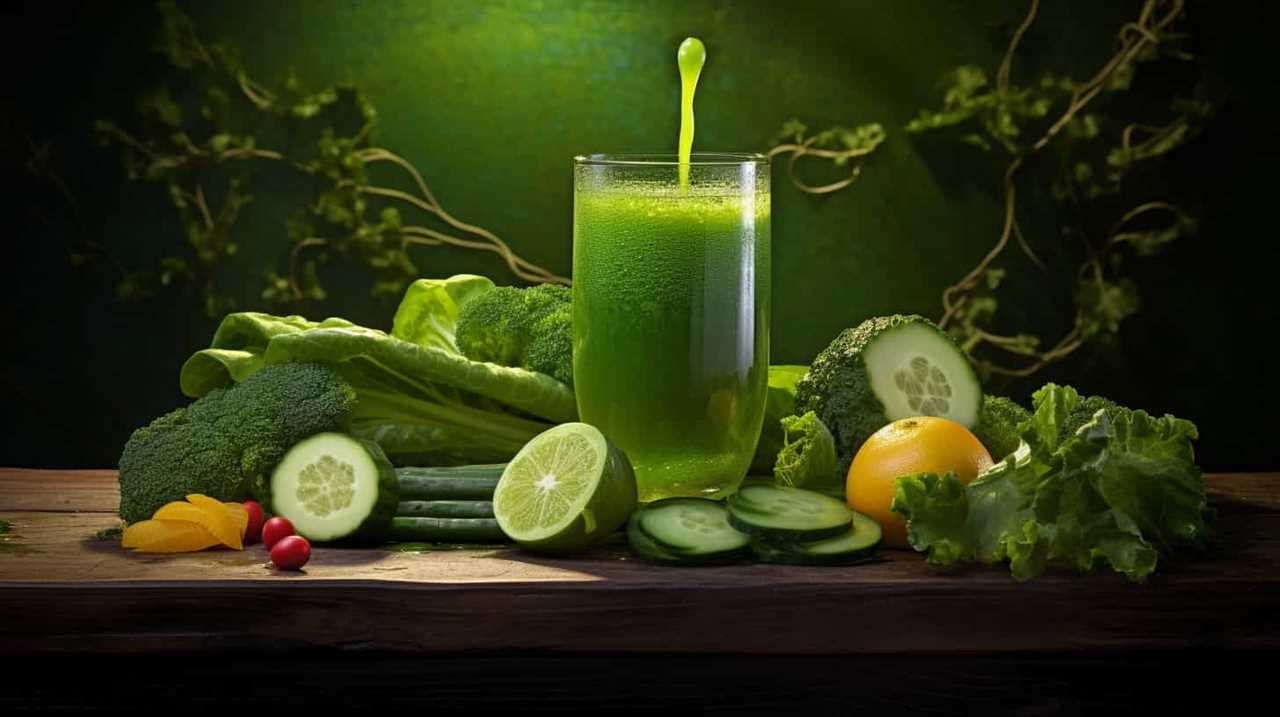
It’s important to start with the right pitcher. Look for a pitcher that’s made of glass or BPA-free plastic, as these materials won’t affect the taste of the lemonade. The pitcher should also have a lid or cover to keep the lemonade fresh and prevent spills.
Now, let’s talk about the lemons. While bottled lemon juice is convenient, using fresh lemons instead can elevate the flavor of your lemonade. Choose lemons that are firm and have a bright yellow color. Give them a gentle squeeze to ensure they’re juicy. To extract the juice, you’ll need a citrus juicer or a reamer. These tools make it easy to get every last drop of juice from the lemons.
Mixing the Lemonade Concentrate
To start mixing the lemonade concentrate, we’ll slowly pour the bottled lemon juice into the pitcher. It’s important to choose the right container for the lemonade concentrate. A pitcher with a lid or a tightly sealed container will help maintain the freshness and prevent any spills or leaks. Once the lemon juice is in the pitcher, we can move on to the next step of adding water and sweetener.
To ensure the lemonade concentrate stays fresh, it’s essential to store it properly. Keep the pitcher in the refrigerator to maintain its cool temperature and prevent any bacteria growth. If you have any leftover concentrate, transfer it to a smaller container with an airtight lid before refrigerating. This will help retain its flavor and prevent any contamination.
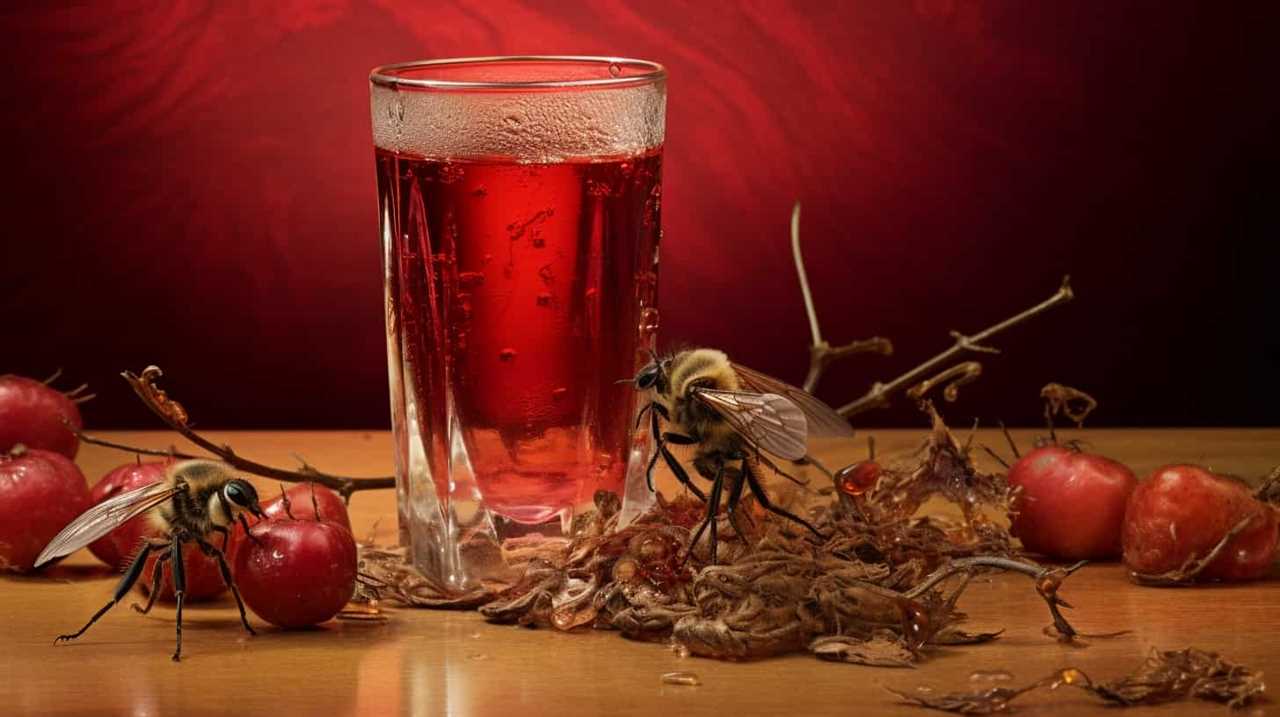
Now that we’ve mixed the lemonade concentrate, it’s time to adjust the sweetness and tartness to taste.
Adjusting the Sweetness and Tartness to Taste
We can adjust the sweetness and tartness of the lemonade to taste by adding more sugar or lemon juice, respectively. If you prefer a sweeter lemonade, simply add more sugar and stir until it dissolves completely. You can experiment with different sweeteners such as honey or agave syrup to find the perfect balance of sweetness.
On the other hand, if you want a tangier lemonade, add more lemon juice gradually, tasting as you go until it reaches your desired level of tartness.
Additionally, you can get creative with your lemonade by adding flavors like fresh mint leaves or a hint of lavender. These additions can elevate the flavor profile and create a more refreshing and unique experience.
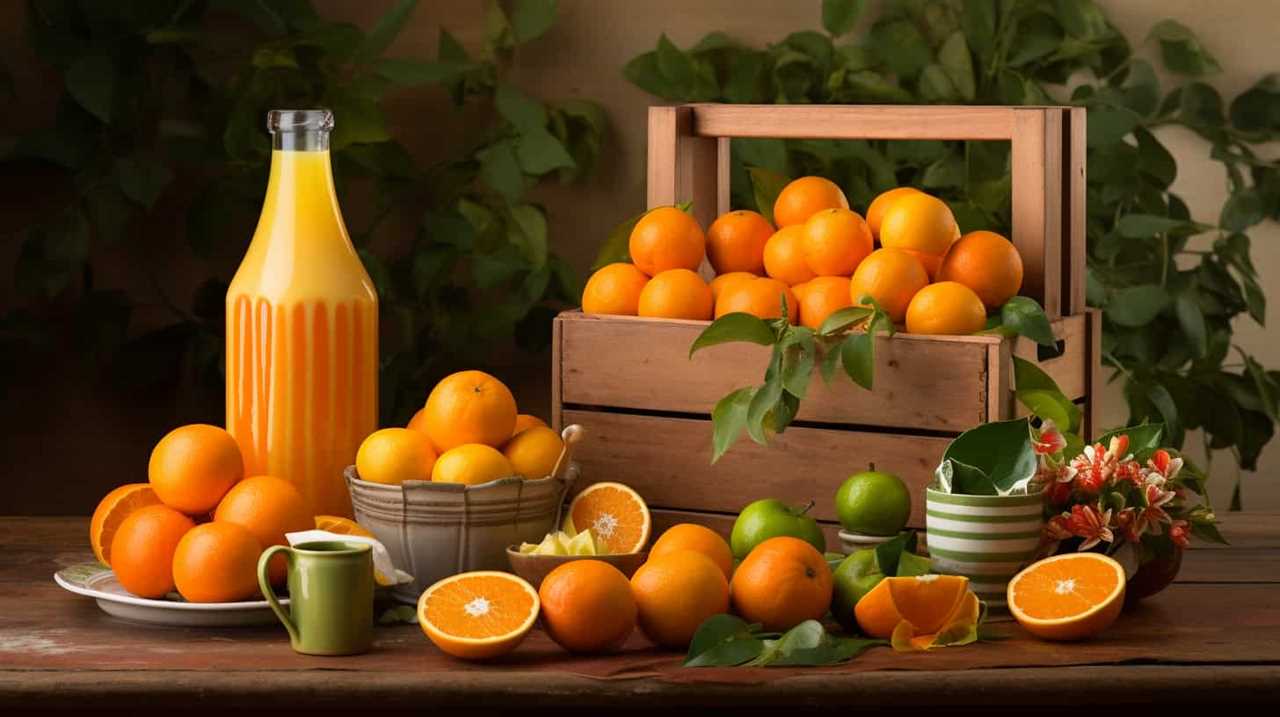
Now that we’ve adjusted the sweetness and tartness of our lemonade, let’s move on to serving and enjoying your refreshing glass of lemonade.
Serving and Enjoying Your Refreshing Glass of Lemonade
Now let’s sit back, relax, and savor our refreshing glass of lemonade.
When it comes to serving and enjoying this delightful drink, there are a few techniques and garnishing options to consider.
Firstly, serving your lemonade chilled is essential for maximum enjoyment. Ensure that you have chilled glasses or add ice cubes to the glasses before pouring the lemonade.

To add a touch of elegance, you can garnish your lemonade with a slice of lemon on the rim of the glass. For an extra burst of flavor, you could also add a sprig of fresh mint or a few berries.
Remember to gently stir the lemonade before serving to evenly distribute the flavors.
Now, take a sip, feel the refreshing tang of lemon, and let the sweet and tart flavors dance on your taste buds.
Cheers!

Frequently Asked Questions
Can I Use Fresh Lemons Instead of Bottled Lemon Juice?
Fresh lemons offer numerous benefits over bottled lemon juice. The taste of fresh lemons is unparalleled, providing a vibrant and tangy flavor. Incorporating fresh lemons into your lemonade will elevate its taste and give it a refreshing and authentic twist.
Can I Substitute Sugar With a Different Sweetener?
Substituting sweeteners in lemonade can enhance the flavor and offer health benefits. We’re knowledgeable about alternative sweeteners and can provide precise, detailed instructions on using them in place of sugar.
How Long Does the Lemonade Concentrate Need to Chill in the Refrigerator?
The chilling time for the lemonade concentrate in the refrigerator is typically around 1-2 hours. Using bottled lemon juice offers the benefit of convenience and consistent flavor for a refreshing glass of lemonade.
Can I Add Other Fruits or Flavors to the Lemonade?
Sure, we can definitely add different fruits or flavors to our lemonade. It’s a great way to experiment with unique flavors and create refreshing, personalized drinks. The possibilities are endless!

How Long Does the Lemonade Stay Fresh in the Refrigerator?
Lemonade made with bottled lemon juice can stay fresh in the refrigerator for about 5-7 days. To maximize shelf life, store it in an airtight container and keep it chilled.
Conclusion
And so, with a few simple steps and the right ingredients, a glass of refreshing lemonade is born.
Like a symphony of flavors dancing on your taste buds, this tangy elixir quenches thirst and brings joy on a hot summer day.
Just a sip transports you to a world of citrusy delight, where the sweetness and tartness blend harmoniously.

So go ahead, indulge in the art of lemonade-making and savor every drop of this sun-kissed nectar.
Cheers to the perfect glass of lemonade!
Susannah expertise lies in researching and compiling evidence-based content on juicing, nutrition, and overall health. She is committed to ensuring that The Juicery World offers accurate, up-to-date, and trustworthy information to empower readers to take control of their health. Susannah’s goal is to inspire individuals to embrace juicing as a way to nourish their bodies and live their best lives.
Juice Tips and Tricks
How to Know if Orange Juice Is Bad

We’ve all been in that situation before – reaching for a glass of orange juice and hesitating, unsure if it’s still okay to drink. Fear not! This article will give you the knowledge you need to determine for sure if your orange juice is still fresh or if it’s gone bad.
With a blend of scientific precision and practical tips, we’ll explore color changes, strange smells, off taste, texture changes, and mold or growth that may indicate spoilage.
Let’s dive in and serve ourselves a refreshing glass of certainty!
Key Takeaways
- Color changes in orange juice can indicate a loss of freshness and shelf life extension, but it doesn’t necessarily mean the juice is bad.
- Unusual or off-putting odors in orange juice, such as sour or fermented scents, can be a sign of poor quality.
- An off taste in orange juice, such as sour, bitter, or fermented flavors, suggests that the juice is spoiled.
- Texture changes in orange juice, such as pulp separation or a thicker consistency, can occur as the juice ages, so it’s important to consume it before the expiration date.
Color Changes in Orange Juice
We should be aware that color changes can indicate whether orange juice is bad.
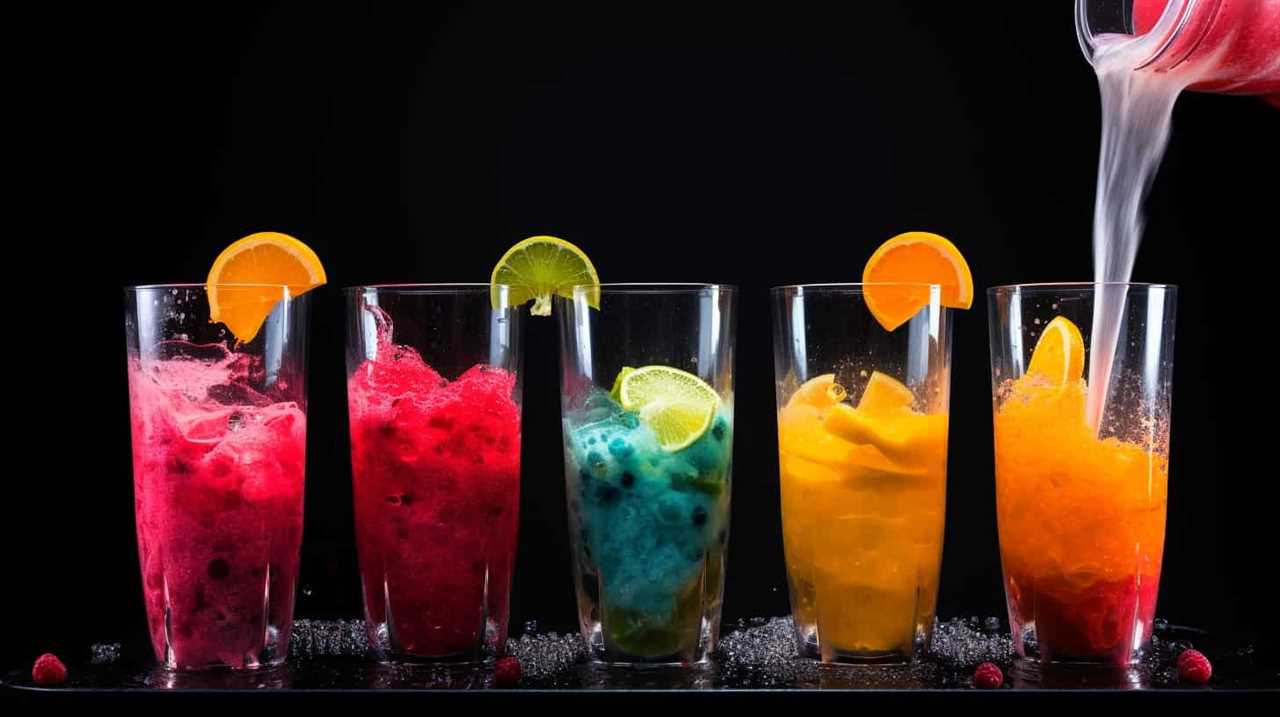
When it comes to orange juice, color is a crucial factor to consider. As oranges are exposed to air, an oxidation process occurs, which leads to changes in color. Fresh orange juice has a vibrant orange hue, indicating its freshness and high nutritional value.
However, as time passes, the juice may undergo a color change, turning dull or brownish. This change in color is a result of the oxidation process, which affects the flavor and quality of the juice. It’s important to note that while a change in color doesn’t necessarily mean the juice is bad, it does indicate that the juice is losing its freshness and shelf life extension.
Therefore, it’s advisable to consume orange juice when it’s at its freshest, as indicated by its vibrant orange color.
Strange Smells in Orange Juice
When it comes to evaluating orange juice, we should be cautious of any strange smells or odors. A fresh, pleasant smell is indicative of good quality orange juice. However, if you notice any unusual or off-putting odors, it may be a sign that the juice has gone bad. These smells can range from a sour or fermented scent to a rancid or moldy aroma.
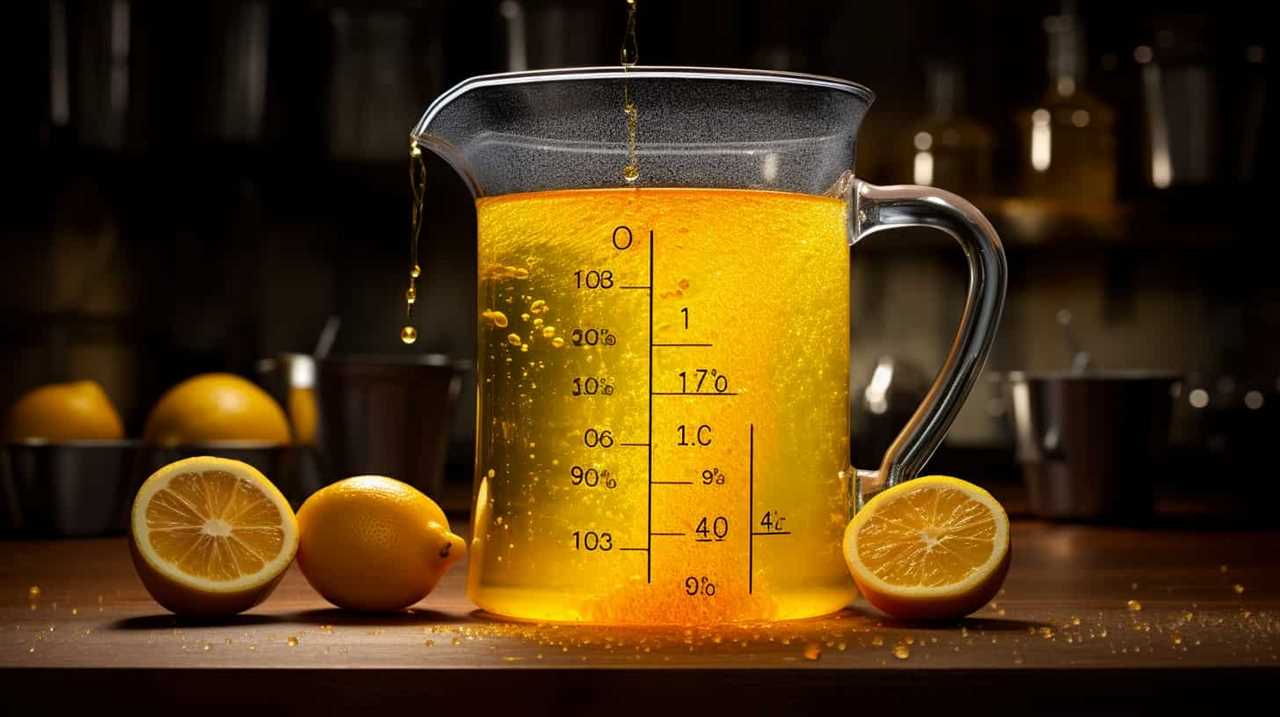
It’s important to note that while some natural variations in scent can occur due to the specific variety of oranges used, any strong or unpleasant smells should raise concerns. If you have citrus fruit allergies, it’s especially important to pay attention to the smell of orange juice, as it could indicate the presence of spoilage or contamination.
Ensuring the quality of orange juice is essential as it’s a popular beverage known for its health benefits, including being rich in vitamin C and antioxidants.
Off Taste of Orange Juice
Our taste buds can detect even the slightest hint of an off taste in orange juice, which can indicate that it has gone bad. The taste of orange juice should be fresh, tangy, and slightly sweet. If it tastes sour, bitter, or fermented, it’s likely spoiled.
One common cause of an off taste in orange juice is the use of overripe oranges. When oranges become overripe, their flavor profile changes, resulting in a less pleasant taste. Another factor to consider is the expiration date. Orange juice that has passed its expiration date is more likely to develop an off taste. It’s important to check the expiration date before consuming orange juice to ensure its freshness and quality. Additionally, improper storage conditions, such as leaving the juice at room temperature for extended periods, can lead to the development of unpleasant flavors. Storing orange juice in the refrigerator helps maintain its freshness for longer. For those exploring different juice options, aloe vera juice flavor tips suggest pairing tart juices with milder flavors to balance the overall taste.
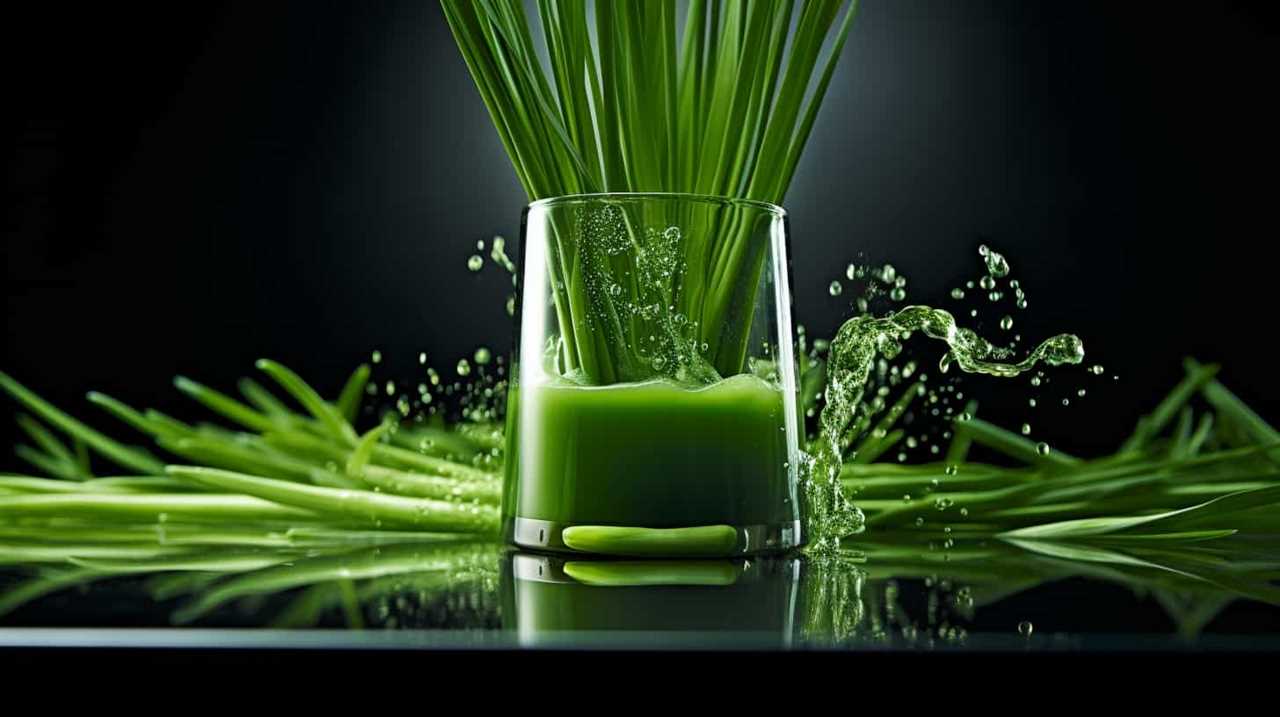
Now, let’s move on to discuss the texture changes in orange juice.
Texture Changes in Orange Juice
As we explore the texture changes in orange juice, it’s important to note that certain factors can cause it to become thicker or develop sediment. One common texture change in orange juice is pulp separation, where the pulp separates from the liquid and settles at the bottom. This can occur naturally over time, as the pulp particles become denser and sink.
Another factor that can affect the texture of orange juice is the expiration date. As orange juice ages, it may start to develop a thicker consistency and even form sediment. This is a result of the natural breakdown of the juice’s components. Therefore, it’s crucial to check the expiration date on orange juice and consume it before it reaches its expiration date to avoid any undesirable texture changes.
Mold or Growth in Orange Juice
We need to be aware of the possibility of mold or other growth occurring in orange juice. Mold can develop in orange juice if it isn’t stored properly or if it has passed its expiration date.

To prevent mold growth, it’s important to follow these steps:
- Store orange juice in the refrigerator at a temperature below 40°F (4°C).
- Check the expiration date on the bottle before consuming. Discard any orange juice that has expired.
- Keep the container tightly sealed to prevent air and moisture from entering, as these can promote mold growth.
Regularly inspecting orange juice for any signs of mold or unusual growth is essential. If you notice any discoloration, a strange odor, or visible mold, it’s best to discard the juice to avoid any potential health risks.
Frequently Asked Questions
Can Orange Juice Go Bad if It’s Stored in the Freezer for Too Long?
Frozen orange juice can potentially lose its nutrients and change its taste if stored in the freezer for too long. It is important to check for signs of spoilage before consuming it.
How Long Can Orange Juice Stay Fresh in the Refrigerator Once It’s Opened?
Once opened, orange juice can stay fresh in the refrigerator for about 7-10 days. To maintain its freshness, store it properly by keeping it tightly sealed and at a consistently cold temperature. If the orange juice develops an off odor, flavor, or appearance, it’s best to discard it to avoid any potential health risks. Factors like exposure to air and varying temperatures can influence how long orange juice lasts, so it’s crucial to handle it with care. Always check the expiration date as a general guide, but remember that proper storage can extend its freshness slightly. Additionally, avoid leaving the orange juice out at room temperature for extended periods, as this can significantly shorten how long orange juice lasts. Freezing the juice can be another option to extend its shelf life, but be aware that this may alter its texture and taste once thawed. By following these precautions, you can ensure your orange juice stays fresh and safe to consume.
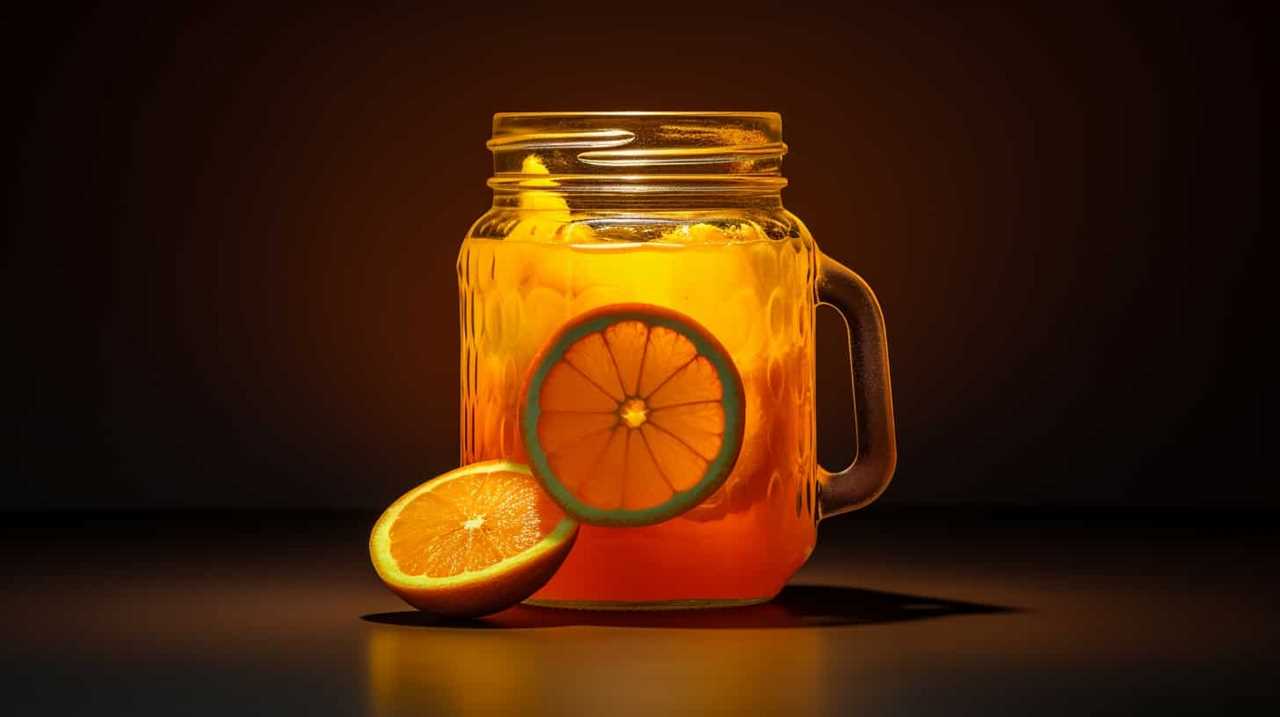
Is It Safe to Consume Orange Juice That Has Been Left Out at Room Temperature Overnight?
Left out orange juice may not be safe to drink as it can harbor harmful bacteria. Signs of spoiled orange juice include a sour smell, mold growth, and a change in color or taste.
Can Orange Juice Develop Harmful Bacteria if It’s Past Its Expiration Date but Still Looks and Smells Fine?
Orange juice can cause food poisoning if it develops harmful bacteria, even if it looks and smells fine. Signs of spoiled orange juice include a sour smell, mold growth, and a change in color or taste.
Does the Nutritional Value of Orange Juice Decrease as It Starts to Go Bad?
As orange juice goes bad, its nutritional value decreases. The longer it sits on the shelf, the more nutrients it loses. Signs of spoilage include a sour smell, off taste, and mold growth.
Conclusion
In conclusion, determining if orange juice is bad requires careful observation of color changes, strange smells, off taste, and texture changes. Just like a detective investigating a case, we must rely on our senses to detect any signs of spoilage.
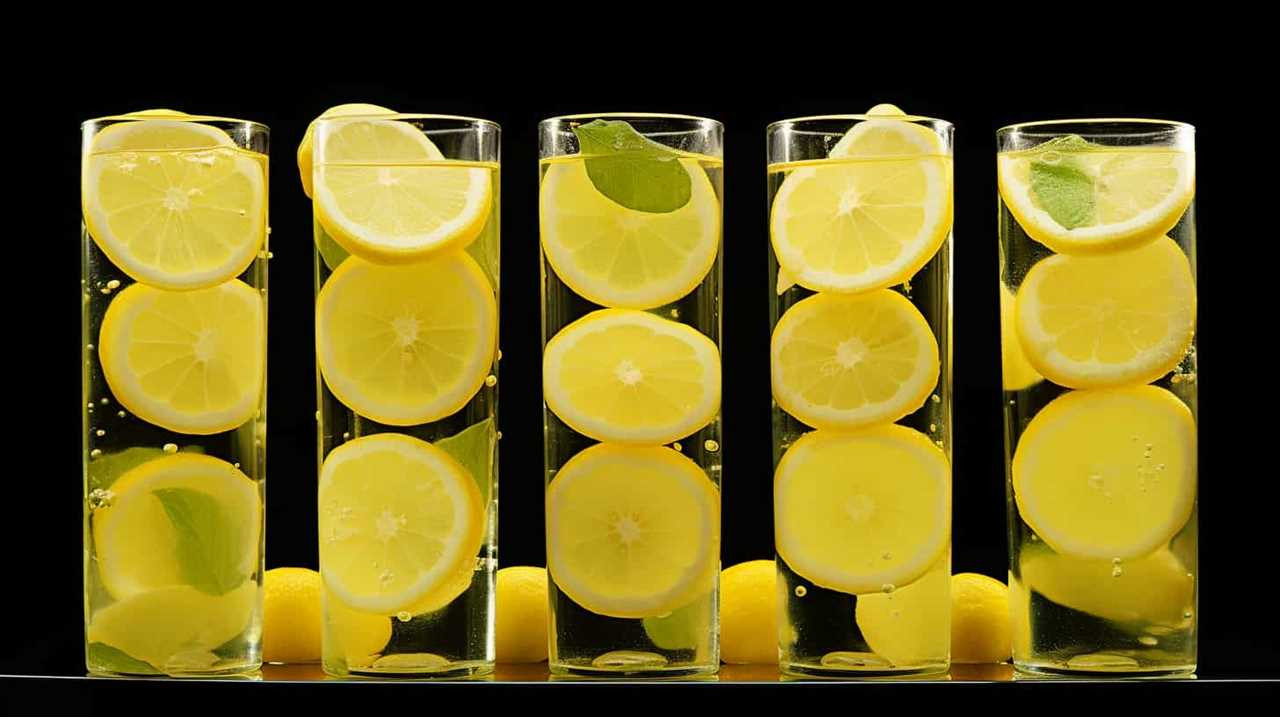
If we detect mold or growth in the orange juice, it’s a clear indication that it’s no longer safe to consume. By remaining vigilant and attuned to these indicators, we can ensure that our orange juice is always fresh and enjoyable.
Susannah expertise lies in researching and compiling evidence-based content on juicing, nutrition, and overall health. She is committed to ensuring that The Juicery World offers accurate, up-to-date, and trustworthy information to empower readers to take control of their health. Susannah’s goal is to inspire individuals to embrace juicing as a way to nourish their bodies and live their best lives.
-

 Vetted2 months ago
Vetted2 months ago15 Best Juices for Diabetics: Refreshing Options That Won’t Spike Your Blood Sugar
-

 Vetted2 months ago
Vetted2 months ago15 Best Decaf Coffee Options for Flavor Lovers Who Need a Caffeine Break
-

 Vetted2 months ago
Vetted2 months ago15 Best Espresso Ground Coffees to Elevate Your Morning Brew
-

 Vetted2 months ago
Vetted2 months ago15 Best K-Cup Coffee Pods for a Perfect Brew Every Time
-

 Vetted2 months ago
Vetted2 months ago15 Best Beans for Espresso: A Guide to Perfecting Your Brew
-

 Vetted2 months ago
Vetted2 months ago15 Best Inexpensive Espresso Machines That Brew Quality Coffee on a Budget
-

 Vetted2 months ago
Vetted2 months ago15 Best Kona Coffees to Savor the Rich Flavors of Hawaii
-

 Vetted2 months ago
Vetted2 months ago15 Best Cold Brew Coffees to Keep You Refreshed All Summer Long








